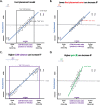Mediolateral foot placement control can be trained: Older adults learn to walk more stable, when ankle moments are constrained
- PMID: 37910445
- PMCID: PMC10619794
- DOI: 10.1371/journal.pone.0292449
Mediolateral foot placement control can be trained: Older adults learn to walk more stable, when ankle moments are constrained
Abstract
Falls are a problem, especially for older adults. Placing our feet accurately relative to the center-of-mass helps us to prevent falling during gait. The degree of foot placement control with respect to the center-of mass kinematic state is decreased in older as compared to young adults. Here, we attempted to train mediolateral foot placement control in healthy older adults. Ten older adults trained by walking on shoes with a narrow ridge underneath (LesSchuh), restricting mediolateral center-of-pressure shifts. As a training effect, we expected improved foot placement control during normal walking. A training session consisted of a normal walking condition, followed by a training condition on LesSchuh and finally an after-effect condition. Participants performed six of such training sessions, spread across three weeks. As a control, before the first training session, we included two similar sessions, but on normal shoes only. We evaluated whether a training effect was observed across sessions and weeks in a repeated-measures design. Whilst walking with LesSchuh, the magnitude of foot placement error reduced half-a-millimeter between sessions within a week (cohen's d = 0.394). As a training effect in normal walking, the magnitude of foot placement errors was significantly lower compared to the control week, by one millimeter in weeks 2 (cohen's d = 0.686) and 3 (cohen's d = 0.780) and by two millimeters in week 4 (cohen's d = 0.875). Local dynamic stability of normal walking also improved significantly. More precise foot placement may thus have led to improved stability. It remains to be determined whether the training effects were the result of walking on LesSchuh or from repeated treadmill walking itself. Moreover, enhancement of mechanisms beyond the scope of our outcome measures may have improved stability. At the retention test, gait stability returned to similar levels as in the control week. Yet, a reduction in foot placement error persisted.
Copyright: © 2023 Mahaki et al. This is an open access article distributed under the terms of the Creative Commons Attribution License, which permits unrestricted use, distribution, and reproduction in any medium, provided the original author and source are credited.
Conflict of interest statement
The authors have declared that no competing interests exists.
Figures














References
Publication types
MeSH terms
LinkOut - more resources
Full Text Sources
Research Materials

